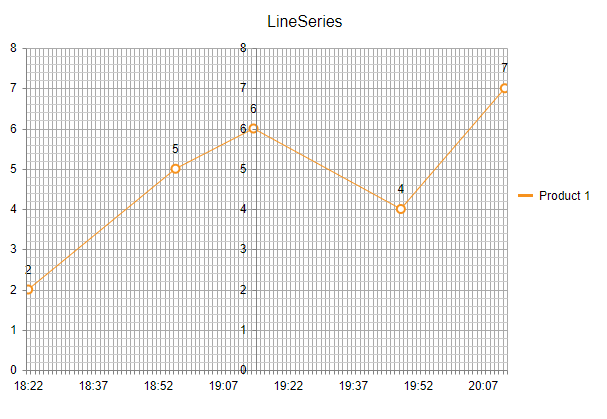Unplanned
Last Updated:
01 May 2019 13:59
by ADMIN
ADMIN
Danail Vasilev
Created on:
11 Apr 2014 07:59
Category:
HtmlChart
Type:
Feature Request
Improve RadHtmlChart XAxis' AxisCrossingPoint so that it accepts DateTime object
For the time being the DateTime object can be set to the AxisCrossingPoint on the client. For example:
ASPX:
<script>
function OnLoadHandler(sender, args) {
var kendoChart = sender.get_kendoWidget();
var opts = kendoChart.options;
opts.categoryAxis.axisCrossingValues = [0, new Date("2014, 11, 05, 19:15:00")];
kendoChart.setOptions(opts);
}
</script>
<telerik:RadHtmlChart runat="server" ID="RadHtmlChart1" Width="600px" Height="400px">
<ClientEvents OnLoad="OnLoadHandler" />
<PlotArea>
<Series>
<telerik:LineSeries Name="Product 1" DataFieldY="SellQuantity">
</telerik:LineSeries>
</Series>
<XAxis DataLabelsField="SellDate" BaseUnit="Minutes">
<LabelsAppearance Step="15"></LabelsAppearance>
<MinorGridLines Visible="false" />
<AxisCrossingPoints>
<telerik:AxisCrossingPoint Value="10" />
</AxisCrossingPoints>
</XAxis>
<AdditionalYAxes>
<telerik:AxisY></telerik:AxisY>
</AdditionalYAxes>
</PlotArea>
<ChartTitle Text="LineSeries"></ChartTitle>
</telerik:RadHtmlChart>
C#:
protected void Page_Load(object sender, EventArgs e)
{
if (!Page.IsPostBack)
{
RadHtmlChart1.DataSource = GetData();
RadHtmlChart1.DataBind();
}
}
protected DataTable GetData()
{
DataTable dt = new DataTable();
dt.Columns.Add("ID", typeof(int));
dt.Columns.Add("SellQuantity", typeof(int));
dt.Columns.Add("SellDate", typeof(DateTime));
dt.Rows.Add(1, 2, new DateTime(2014, 11, 05, 18, 22, 22));
dt.Rows.Add(2, 5, new DateTime(2014, 11, 05, 18, 56, 22));
dt.Rows.Add(3, 6, new DateTime(2014, 11, 05, 19, 14, 22));
dt.Rows.Add(4, 4, new DateTime(2014, 11, 05, 19, 48, 22));
dt.Rows.Add(5, 7, new DateTime(2014, 11, 05, 20, 12, 22));
return dt;
}
5 comments
ADMIN
Vessy
Posted on:
01 May 2019 13:59
Victor
Posted on:
29 Apr 2019 15:31
ADMIN
Vessy
Posted on:
13 Mar 2019 14:37
Paul
Posted on:
06 Mar 2019 21:16
Michael
Posted on:
16 Apr 2014 10:49

